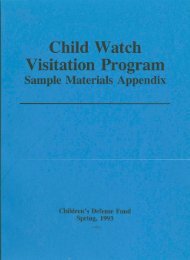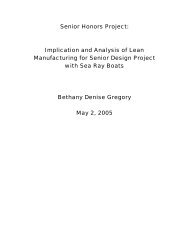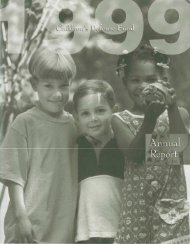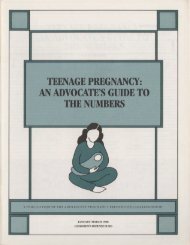children out of school in america - University of Tennessee Digital ...
children out of school in america - University of Tennessee Digital ...
children out of school in america - University of Tennessee Digital ...
Create successful ePaper yourself
Turn your PDF publications into a flip-book with our unique Google optimized e-Paper software.
4. Cont<strong>in</strong>uous evaluation.<br />
Special education placement should not be a dead<br />
end. Evaluation should be an on-go<strong>in</strong>g process.<br />
Most academic measurement occurs only at <strong>in</strong>frequently<br />
spaced <strong>in</strong>tervals. Such measurement does<br />
not allow the teacher to monitor the effectiveness <strong>of</strong><br />
<strong>in</strong>structional procedures so that they can be redesigned<br />
for <strong>in</strong>dividual <strong>children</strong>. Such measurement<br />
also does not monitor change <strong>in</strong> a child's performance.<br />
Children may have great difficulty or may<br />
improve dramatically with<strong>in</strong> widely spaced assessments<br />
- and it will go unnoticed. Assessment <strong>of</strong><br />
<strong>children</strong> with special needs is not a one-time practice<br />
to be followed up at two- or three-year <strong>in</strong>tervals (as<br />
is the present practice <strong>of</strong> many states).98 For <strong>children</strong><br />
placed with<strong>in</strong> a special program, provision<br />
should be made for the on-go<strong>in</strong>g measurement <strong>of</strong><br />
their <strong>school</strong>room function<strong>in</strong>g at regular, short-term<br />
<strong>in</strong>tervals, with the option always available to change<br />
programs or move back to a nonspecial class.<br />
Due Process <strong>in</strong> Special Education Placement<br />
Any assessment that results <strong>in</strong> a change <strong>in</strong> the<br />
child's educational program should also require the<br />
fully <strong>in</strong>formed and written consent <strong>of</strong> the child's<br />
parent or guardian before it may be begun. Under<br />
no circumstances should a child be removed from<br />
the regular educational program until a complete<br />
evaluation, compris<strong>in</strong>g the four essential components<br />
described above, has been performed and the results<br />
<strong>of</strong> the evaluation presented to an educational placement<br />
committee. This committee should <strong>in</strong>clude no<br />
fewer than: 1) the assessment speciaUst most <strong>in</strong>volved<br />
<strong>in</strong> the evaluation, 2) the child's present<br />
teacher, 3) the child's potential teacher, 4) the<br />
child's parents, and 5) the child, whenever possible.<br />
The parent and child should be permitted counsel<br />
or an advocate <strong>of</strong> their choos<strong>in</strong>g and have complete<br />
access to the materials upon which the evaluation is<br />
based. In addition, other policies should be <strong>in</strong>corporated<br />
<strong>in</strong>to special education procedures to become<br />
r<strong>out</strong><strong>in</strong>e educational practice, such as:<br />
1. All communication concern<strong>in</strong>g assessment<br />
should be <strong>in</strong> the native language <strong>of</strong> the parent or<br />
legal guardian.<br />
2. Parents should be notified <strong>in</strong> writ<strong>in</strong>g that<br />
their child has been referred for an assessment.<br />
They should be notified as to who recommended<br />
the referral and the particular purpose <strong>of</strong> the evaluation<br />
<strong>in</strong> detail.<br />
3. The assessment devices to be used <strong>in</strong> the<br />
evaluation should be described, as much as possible,<br />
<strong>in</strong> non-technical term<strong>in</strong>ology.<br />
4. A tentative schedule for start and completion<br />
<strong>of</strong> the evaluation should be agreed on.<br />
5. A completion date for the development <strong>of</strong><br />
an appropriate educational program also should<br />
be agreed on.<br />
6. The parents should be told <strong>of</strong> their rights<br />
to reject or accept both the assessment and the<br />
educational program.<br />
7. The parents should then decide if their<br />
child is to be assessed. Such permission should be<br />
<strong>in</strong> writ<strong>in</strong>g.<br />
8. Parents should also have the right to all<br />
records giv<strong>in</strong>g rise to and generated by the assessment.<br />
Local districts could provide a tra<strong>in</strong>ed<br />
assessor to <strong>in</strong>terpret the evaluation to parents.<br />
However, even with<strong>out</strong> such a person, the parents<br />
should have access to raw data, <strong>in</strong>clud<strong>in</strong>g IQ<br />
scores and teacher judgments.<br />
9. F<strong>in</strong>al or <strong>in</strong>terim written reports should not<br />
be distributed until parents have seen a copy <strong>of</strong><br />
the evaluation. The parents should be given the<br />
opportunity to clarify po<strong>in</strong>ts and to add further<br />
material. If there is a disagreement between the<br />
evaluator and the parents, an opportunity for the<br />
parents to provide a dissent<strong>in</strong>g view (<strong>in</strong> writ<strong>in</strong>g,<br />
if warranted) should be <strong>of</strong>fered.<br />
10. The parents should decide to whom the<br />
written evaluation may be released. The <strong>school</strong><br />
should not decide to send <strong>out</strong> material ab<strong>out</strong> any<br />
child with<strong>out</strong> parent permission.<br />
II. The <strong>school</strong> may decide, <strong>in</strong> the face <strong>of</strong> parental<br />
refusal for assessment and/or placement,<br />
that assessment and/or placement is essential. In<br />
such a case, a specific statement <strong>of</strong> need and<br />
record <strong>of</strong> parental refusal could then be forwarded<br />
to the super<strong>in</strong>tendent <strong>of</strong> <strong>school</strong>s for review <strong>in</strong><br />
terms <strong>of</strong> the attendance, child welfare, or child<br />
98 Appendix N, Table III summarizes present provisions for<br />
special education <strong>in</strong> the districts we visited.<br />
113














